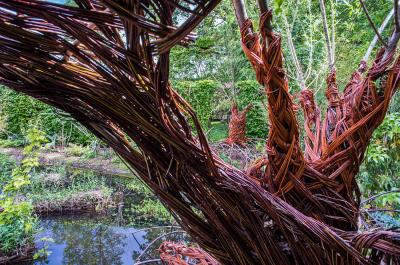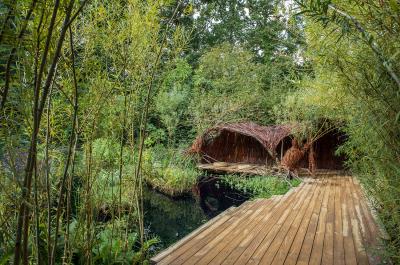This garden draws on the driving forces prompting humans and nature alike to start over and build afresh rather than to resign themselves to fate. Inspired by the natural appearance of mangroves and of floating and cultivated gardens around Lake Inlé in Burma, this garden transposes these two landscapes of hot countries in our part of the world through living willow farming. Just like the mangrove, willows manage to safeguard banks, taking root in or even moving with a river's current. They bend, twist and curve to make floating modules as well as primitive architecture, offering both a place of refuge and contemplation.
This garden is not so much about a passive or hostile nature that needs bringing under control. Que vienne la pluie is designed as a laboratory where human action is subtle, reversible and joyful, in refound, almost symbiotic harmony.
DESIGNERS
Frédérique LARINIER, landscaper/agricultural engineer, Gaël BARDON, landscape-gardener and Emmanuel PUYBONNIEUX, basket weaver
FRANCE

From left to right: Frédérique Larinier, Gaël Bardon and Emmanuel Puybonnieux
Frédérique Larinier
"The history of the "Que vienne la pluie" garden begins in the wake of disastrous water damage...". This is the type of poetic anomaly that I like to express in new ways, or capture, in my work as a landscaper. But let's go back to the beginning... Graduating in 2003 from the National Engineering School of Agricultural Techniques, I chose to specialise in landscape approaches through a Landscaping and Spatial Planning Master in Marseilles in 2005. I feel drawn by sweeping landscapes and what they have to tell us, and study the social images that shape our perception of space. As such, in 2005 I undertook a study at the French National Institute for Agricultural Research (INRA) on the peri-urban landscape to more clearly understand where zones of tension and experimentation between rurality and urbanity lie. More generally, my experience as an agronomist has made me aware of the close ties between human activity and landscape change, between ecological dynamics and management methods. In 2009 I moved to the Limousin region as a landscaper, combining a rational perspective with a more introspective and artistic approach. Fascinated by ecosophy and geobiology alike, in 2015 I travelled to China to go back to the roots of feng shui. I am continuing this exploration today in my transition towards development practices in keeping with the surroundings and which show respect for ecosystems. From the scale of large regions to the microcosm of the garden, I thus approach space in an intuitive, inquisitive and multidisciplinary way, never losing sight of the fact that landscape is above all a reflection of who we are.”
Gaël Bardon
"Born in Limoges in 1983, I gained my first experience of gardening when I was 15, in Objat, Corrèze, where I was able to get to grips with the basic techniques. What I learned is that gardens are as complex as they are fragile! A garden is simply an environment, on a small scale. The changing seasons wield enormous influence ... For me, my work has become a depiction of Man dispatching with the seasons: the autumn leaves are swept up to make way for the winter frosts and snow ... After a conventional study pathway, Vocational A Levels in Landscape Work, I began my career as a gardener for a local authority in the Haute-Vienne département. Four years later I wanted to broaden my sights, all the while honing my creative sensitivity. I therefore enrolled in evening classes to do a BTSA two-year higher-education course in landscape planning at Angers Graduate School of Agriculture. I followed this up with a vocational bachelor's degree in project coordination, "computer graphics" option, geared towards acquiring skills in the computer graphics of architect firms or engineering firms. In 2012, with this degree under my belt, I left my job after 10 years of public service to set myself up freelance. First and foremost, gardening is a way for me to earn a living and develop my skills as a graphic designer. I have been adding new strings to my bow in my freelance adventure, and have progressed from being a graphic designer for engineering firms to one specialising in business communication. These days, I design and produce their communication material in paper and digital form. My "geek" background and the reality of garden upkeep projects are catching up with me and taking over my landscaping aspirations. I therefore find myself constantly torn between nature and web culture. I’m always of two minds ... but I progress!"
After dabbling in a range of professions, Emmanuel Puybonnieux decided to completely change tack in 2000, enrolling at the Fayl Billot National School of Willow Growing and Basketry. This is how he became a basket weaver, following in the footsteps of his grandfather and reviving a local tradition from the Creuse département, forgotten since the mid 20th century. Starting out in the Creuse before moving to Aixe-sur-Vienne, Emmanuel has been expanding his craft business. He also grows numerous varieties of willow which, without his know-how, would have sunk into oblivion. He handles living and dried willow as well as chestnut wood, a raw material he uses to make monumental structures for gardens and more traditional wickerwork alike. He also passes his passion on through training courses he gives at local authority level and for the general public.




